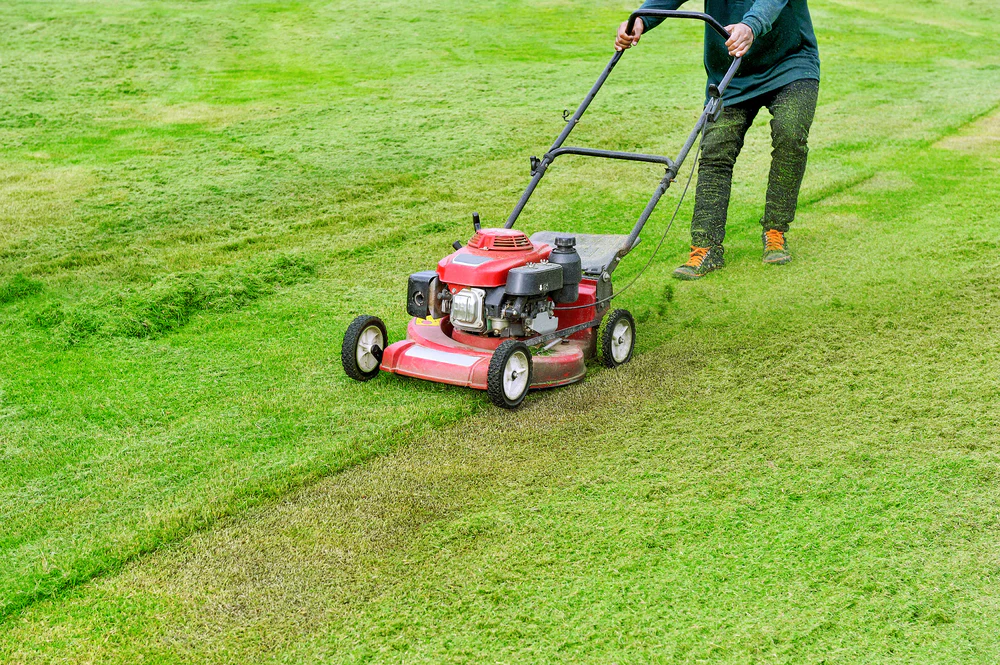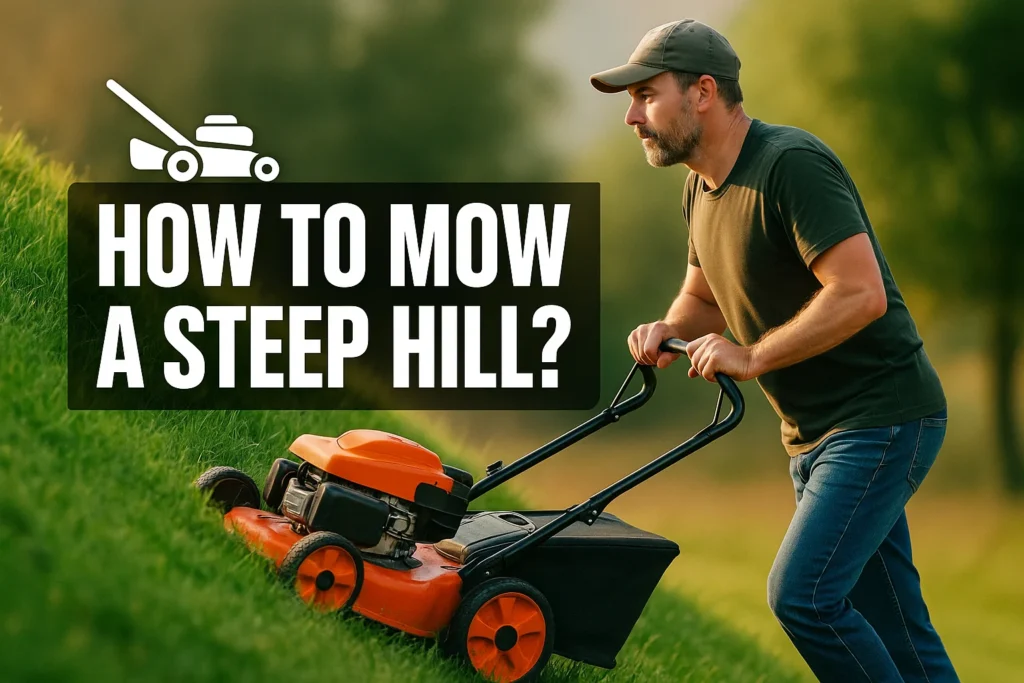Mowing a steep hill may require more physical effort than mowing a flat surface. It requires more strategy, attention to safety, and the proper technique to get the job done. Whether you’re operating a push mower or a riding model, you need to know how to mow a steep hill and what to do to ensure the process is smooth, the cut is clean, and you stay safe. In this blog, we will break down the factors you need to consider for effective and safe mowing hills.
Mowing Direction: Up & Down vs. Side-to-Side
Selecting the right mowing direction is important for safety, as well as the health of your lawn. For push mowers, to be safest, mow across the slope. This minimizes the risk of losing the footer or the mower roll-back. If you’re using a riding mower, you should mow the hill up and down, not side to side. This keeps your balance in check and keeps your risk of tipping over to a minimum. Access the steepest to check and change direction. Especially steep areas, avoid a mechanical mower—you’ll either have to trim by hand or leave the job to hand or professional tools.
Proper Speed & Throttle Control
Speed is very important when mowing hills safely. If you’re operating a self-propelled or riding mower, keep from suddenly accelerating or decelerating. Take it slow and steady, particularly on downhills. Otherwise, the rapid movements on the incline can also cause the mower to slip or get out of control.
The throttle should be set only as high as is needed to drive through the grass without overworking the mower. Slower speeds offer more control, which is particularly crucial when cornering or avoiding crossing traffic on a hill.
How to Avoid Scalping or Uneven Cutting

Scalping refers to when the blade of the mower head hits the surface of the soil too low to the ground, inside it, or next to it, which is often a result of uneven ground. It’s easy to do this on a slope if the mower hanging down isn’t level, or if the wheels bounce as the machine tilts. To avoid this:
- Set the cutting height to be a bit higher than normal.
- Avoid pressing down too hard on the mower.
- Follow the contour of the hill and don’t push the mower into dips or ruts.
On riding mowers, make sure the deck is level before you begin. Making several, lighter passes can also prevent scalping and lead to a more even cut.
Best Mowers for Steep Hills
Selection of the best lawn mower for steep hills is not just a matter of preference, but an important step towards safety as well as efficiency. Not all mowers can handle an incline. Moreover, using the wrong tool for a slope can create accidents, uneven cuts, and mechanical failures. And whether you’re mowing a gradual slope or a more steeply inclined backyard, a mower designed for hills can make the difference.
Riding Mowers vs. Walk-Behind Mowers for Slopes
When it comes to mowing on a hill, the type of mower you select influences a lot, including the quality of the cut and your safety. Push mowers typically work better on moderate slopes, especially if they are self-propelled. They allow more control, so you mow and cut side-to-side.
Riding mowers are good for larger lawns with relatively gradual slopes. But not all riding mowers are good for a steep hill. Use only models with a low centre of gravity, a wide wheelbase, and high stability control. With riding mowers, the greatest safety hazard is the possibility of tipping over. Always follow the manufacturer’s advice regarding slope ratings, and avoid mowing up and down a slope while riding.
Top Slope Mowers (John Deere, Husqvarna, etc.)
Some of the brands are known for their reputation of the best slope-friendly mowing equipment. These are some of the best options for homeowners and pros alike:
- John Deere X500 Series
- Husqvarna TS 354XD
- Cub Cadet XT1 Enduro Series
- Troy-Bilt Super Bronco XP
- Ferris + Altoz Commercial Mowers
It is always best to check the manufacturer’s slope rating. Some of these models can handle slopes of 15 degrees or more with cautionary measures.
What to Look for in a Hill-Friendly Mower
How to choose a mower for hills. If you are in search of a mower for hills, look for these key features:
- Traction Control: A tight grip on angled terrain is a must.
- Weight balance: provide better balance on an incline.
- Engine Power and Transmission: make it easier to vary speed and direction on hills.
- Deck Size and Height Adjustment: You can prevent scalping.
- Durability and build quality: need to use regularly on hilly or uneven ground.
A poor match for a slope doesn’t just make the job more difficult — it can even be dangerous. Target mowers are designed to address the unique challenges of hillside mowing.
Alternative Methods for Tough Slopes
In some cases, mowing with conventional equipment on a steep hill isn’t practical. There are ways around it that can be safer and easier. These alternatives are particularly helpful in rugged terrain, narrow areas, or where there is thick vegetation.
Using a String Trimmer or Brush Cutter
On slopes that are too steep or lumpy for wheeled mowers, string trimmers and brush cutters are a lightweight, nimble alternative. These hand-held tools enable you to trim grass and weeds on the slope while standing firmly, or to move along the more level ground.
Brush cutters are perfect for clearing dense vegetation, tall grass, and even some light brush. They are commonly put into use in places that riding mowers can’t reach or where slope gradients exceed the manufacturer’s safety recommendation.
This approach is particularly handy in areas like retaining walls, ditches, and other spaces that your mower deck won’t easily reach.
Manual Tools ( such as Scythes, Reel Mowers ) for Small Areas
- Scythes
- Reel Mowers
- Grass Shears
- Hedge Clippers
- Serrated Grass Sickles
These work best for delicate patches or spots too fragile for powered equipment.
When to Hire a Professional with a Slope Mower
Unfortunately, some hills are just too dangerous or labor-intensive to handle on your own. In these situations, taking on the services of a lawn care expert with a dedicated slope mower could be the smartest and safest option.
Lawn care professionals use remote-controlled mowers, track-driven equipment, or specially designed riding mowers to create professional-looking ridges with safety measures. They’d better handle rough terrain fast with a lower risk of injury.
Consider for:
- Slope Inclines over 15–20 degrees
- Areas with Loose Soil, Rocks, or Erosion Issues
- Big properties with lots of hillside portions
- Overgrown or brushy areas
Investing in professional help will also save your back and health, and protect you from any unnecessary accidents.
Maintaining Your Mower for Hill Use
Employing a mower on a steep hill added strain on its parts, particularly the tires, blades, and engine. To keep your equipment performing, effective, and long-lasting, perform maintenance on your machine regularly for hillside mowing. Regular maintenance enables the cutter to avoid mechanical breakdown, provide cleaner cuts, and reduce the risk of accidents when working on second-growth and hilly terrain.
How to Check Tire Pressure & Tread
Mowing a hillside requires good traction and balance, and your tires are the most important factor. Begin with regularly checking the tire pressure — underinflated tires can compromise grip and lead to more frequent sliding, particularly when mowing uphill or downhill. “Use a good quality tire gauge and set the pressure according to your mower’s manual.
In addition, check tread depth. Threadbare tread diminishes traction even on wet or slippery grass. New tires should be installed if the tires are smooth or unevenly worn. For hilly terrain, go with something high-traction or lug-style for traction and stability.
Sharpening Blades for Cleaner Cuts on Slopes
Sharp blades are a must for a uniform cut, which is especially challenging on sloped ground where uneven pressure and angles can play havoc with consistent cutting. If your blades are dull, they will rip grass rather than providing the clean cut necessary to maintain a healthy lawn, which can cause your lawn stress and lead to an uneven, patchy-looking cut.
So, check your mower blades frequently, especially after running over rough or uneven ground. If you see torn grass tips or uneven cuts, it’s time to sharpen the blades. Redress with a sharpening file, angle grinder, or blade sharpener. With your blades, if they can’t be straightened or nicks removed, it may very well be worth replacing instead of repairing.
Storing Your Mower After Hill Mowing
Proper Storage ensures your mower stays strong in top toughest slope conditions. However, proper storage keeps your mower in a condition better than ever. Always clean grass clippings, dirt, and moisture from the underside and blades after each use to prevent rust and corrosion.
If you’re storing the mower longer than a few days:
- Drain or stabilize your fuel to prevent engine issues.
- Inspect for loose bolts or parts, especially after rough terrain use.
- Keep on flat ground to prevent leaks of oil or fuel, especially for the gas-powered models.
- Storing your mower in a dry, sheltered place.
Conclusion:
Mowing on a slope doesn’t have to be dangerous. Under the right schedule, safety precautions, and with the right equipment, you can maintain a well-kept hilly yard throughout the season. Don’t compromise on safety. To ensure proper execution, plan carefully, invest in the right gear, and follow these tips.
FAQs
Most residential riding mowers are considered safe for handling slopes to 15 degrees. More than this can increase the risk of tipping over or losing control, especially if mowing up or down the slope. “Certain of these specialized mowers can handle a 20 and even up to 25.
Zero-turn mowers can maneuver well, but typically don’t handle steep hills well. However, some commercial-grade zero-turns are designed with better weight distribution and drive tangling systems for only gentle hillside use. For more severe slopes, stick to walk-behind mowers or models designed to handle ups and downs.
A mower ramp can also help your equipment for storage if you have an overhead shed or space to store your tools. Here’s a quick and easy guide to the process:
Measure the Height
Calculate the Ramp Length
Choose the Right Materials
Install Anti-Slip Surface
Secure the Ramp



